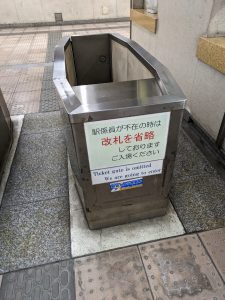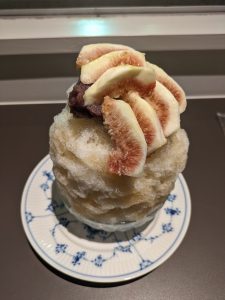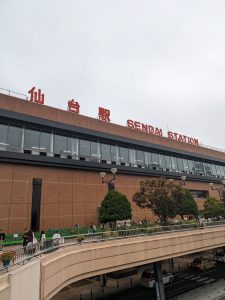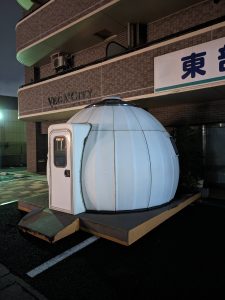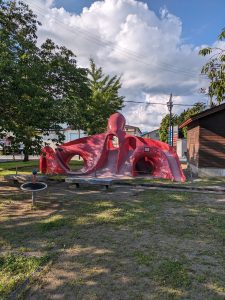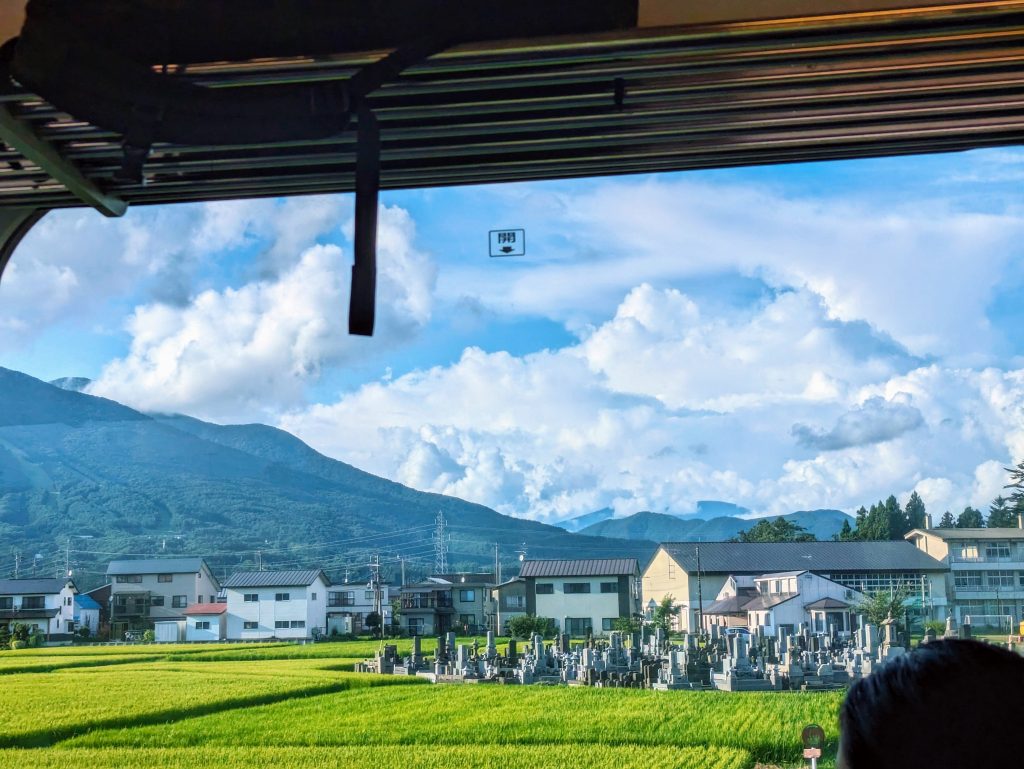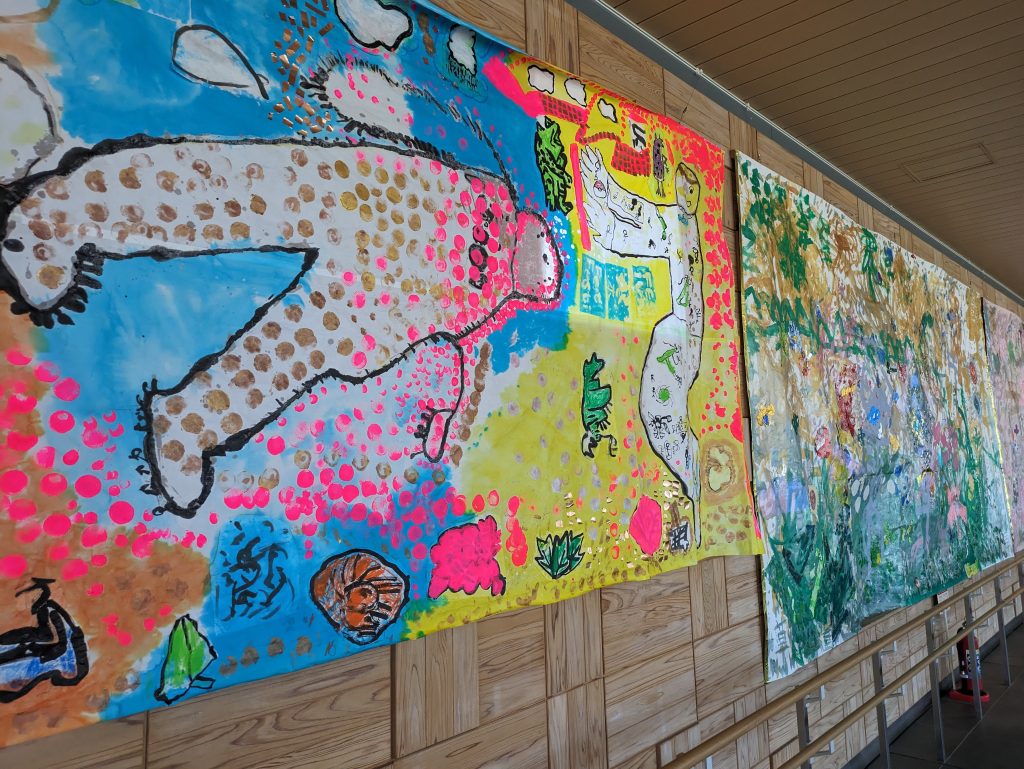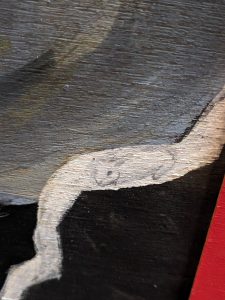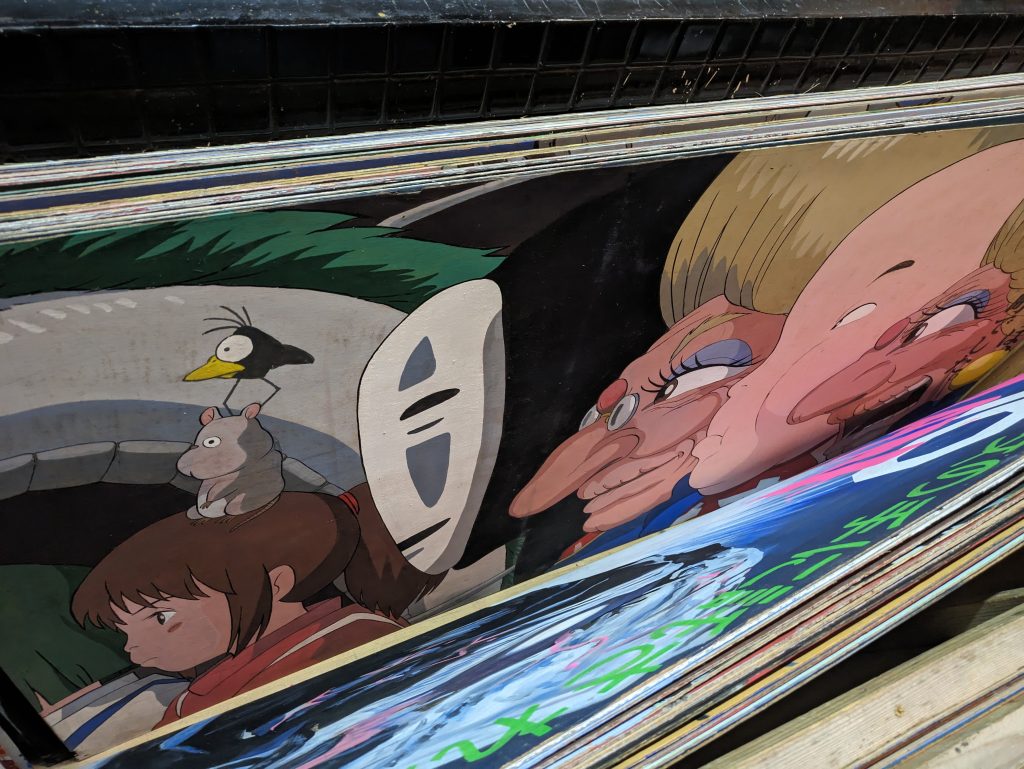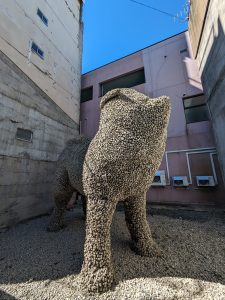OK, I’m a convert. Sitting on trains for up to eight hours a day, mostly as a way to escape the up-to-40°C / 104°F temperatures outside and sit inside an air-conditioned vehicle? Getting to pay a flat rate for unlimited rides on JR local lines across the country? Finally getting to travel back up to Tohoku (north-eastern Japan) for the first time in seven years? Absolutely yes, sign me up. I was a little worried it might be too much for me going in, too much sitting, or too much traveling and transit-ing, but in reality, I can’t wait to do it again.
Every summer (actually three times throughout the year, for a fixed amount of time only) all the Japan Railways Group companies release the Seishun 18 Kippu, or the “Youth 18 Ticket”, a discount railway pass (intended for poor students, hence the name, although with no age limit or rider restrictions) which allows users to ride an unlimited number of JR trains and lines across the country for five non-consecutive days1Well… more on this at the end. for a pretty affordable price. The catch is that it only gets you access to conventional lines, which are of course slow, stopping at nearly every single station – no high-speed limited expresses or shinkansen, not even if you pay the express fare on top. But this ticket is famous in Japan, well-known and well-loved since the summer of 1982 when it first went on sale. As a public transit aficionado, it felt like a rite of passage for me to at least use it once during my time living in this country, right?
Well, slightly unluckily for me, the very very similar “Hokkaido & East Japan Pass” worked out better for the itinerary I was devising: it’s good for seven days instead of only five (superior), it can’t be transferred between people (that’s fine, it’s only me either way), the days must be consecutive (also OK, I was doing a lot of traveling every day), it’s limited to eastern & northern Japan (makes complete sense for my plans), and it’s cheaper, only ¥11,330 ($78.17)! But nobody has ever heard of this ticket, and it’s a mouthful to say when talking to people… So, whatever, this is essentially my Seishun 18 Kippu journey, and I’m referring to it as that2In the blogpost title, I’m making a pun via use of English furigana (phonetic notation), referencing that the number 18 in Japanese is read as “juu-hachi”, but I wasn’t really using this ticket, so I’ve specified an alternate potential reading of “juu-pachi”, with ‘pachi’ referring to something that’s a fake, knock-off, or forgery. in quotation marks, just for the sake of an understandable explanation, even if that’s technically not the pass I was using over this week I had off for the Obon holidays.
So! What inspired my path? Well, IC cards of course! And because 1) the Koshinetsu region was an area of Japan I’d never traveled to or even through before, and 2) it’d been years since I’d been up to Tohoku, but never by myself, and at the time a friend and I did a very different route (in a car! gross!) than the one I did this time around. I knew I had various clusters of places to hit up, so I set to making a custom Google “My Maps” map, embedded above. The Tohoku region has over a dozen different IC cards cards available, most of which are the 2-in-1 “regional cooperation” cards that you can read all about on that Wikipedia article which I also wrote all of (lol).
Between the Tohoku cards and the ones along the Sea of Japan coastline, I had nearly 20 new ones to nab, and planned to get copies for me and other hobbyist friends. The project then turned into narrowing down which sales centers for each card were close to a train station, which would be most viable for me to go to, looking up business hours on websites and confirming each one usually by phone call over the course of weeks… it also involved looking a lot at Ekispert‘s amazing scalable map of every train line in the country to see exactly where I could get to from where, checking Google Maps and – much better, minus the language barrier if you don’t speak Japanese – Yahoo! Transit to figure out local/rapid train times and connections, and making a big itinerary on Google Docs.
For a vague outline:
I started out by buying a base fare ticket from Nagoya to Niigata, and stopping off at various points, Nakatsugawa and Shiojiri Stations to grab eki-stamps and transfer trains, Nagano City to spend the night, then taking the Hokuriku Shinkansen one stop to Joetsumyoko, and transferring to the Shirayuki limited express to reach Niigata. Then the third day my pass kicked in, and it was good for the rest of the time. My trip from here took me north out of Niigata, stopping in Shibata, to Tsuruoka, where I took a very windy highway bus through the mountains of Yamagata (on Mountain Day, at that!) to Sendai. I did a big southern loop (more like a figure ‘6’, or ‘9’) over to Yamagata, then Koriyama, and over to the tiny town of Inawashiro just shy of Aizuwakamatsu, then back over and back up via Fukushima to Sendai.
The next day I left Sendai eastward, doing a bunch of transfers (at Kogota and Maeyachi) and riding on tiny one-car trains to get over to Yanaizu, where the BRT potion of the Kesennuma Line starts, the former railway line having been converted into a bus route driving down a special bus-only road (and operated by JR as a train line) following its destruction in the 2011 earthquake and tsunami. This took me to the terminus, Kesennuma Station, where I rode the Pokémon with You train!!!!! (one of JR East’s Joyful Trains which also seek to revitalize the region) to Ichinoseki. And then up from there to stay in Morioka.
From Morioka, I did a day trip where I bopped over westward to Akita and back, one way on the Akita mini-shinkansen (that decouples from a larger train at Morioka Station!) and the other on local lines featuring a cool switchback at Ōmagari Station. The day after, I continue northward, this time on a host of third-sector railway lines (another Wikipedia article I wrote lol…) to Hachinohe, and then curving over to Aomori. The bulk of it is over now!
Aomori was a bit more relaxed, but the following day I rode the Ōu Main Line down toward Odate, actually across the prefectural border into Akita again, and then back up, stopping in Hirosaki on the way. Finally, on the day I headed home, I hopped on the Hokkaido Shinkansen (with a discount ticket I could get with my pass) to drop by Hakodate, and then took the 300 km/h shinkansen (two trains, three titles!) allllllllllllllllll the way back home from there.
I know, I know, you’re thinking “those four paragraphs aren’t vague” but, really, they are! It was a lot more complicated than this, and took a ton of planning (which was fun, though!) Most train times were totally up-in-the-air, so I just made notes of rough plans, examples of departures over the span of a couple hours at which I was most likely to leave, along with how often trains came, and specific last-possible-departure times written down for the connections I absolutely had to make. Also, despite the detail, the flexibility was very nice to have, and I really never felt rushed or like I had to punctually stick to some predetermined schedule I had come up with for myself. Not like I’m that good at being on time for things anyway…
Compared to previous trip reports, this one will be told via heavy use of pictures as opposed to paragraphs of text… but either way, so much will get inevitably left out. Each card I got and place I went had a story behind it, usually one that was quite amusing or unexpected, and I had time to do quite a few other things in the cities I stayed in and was traveling through as well. I’ll try to remember and write about as much as I can – though for my own sake while writing this, and in pursuit of trying to not spend ages on this blogpost as much as I have previous ones (since I’ve already put this off so much!) stuff will be a bit curtailed. But I’m happy to provide more info or details about anything if you leave a comment below or ask!
Here were all my tickets, followed by my pictures and anecdotes broken up by day:

Top left: Base fare ticket for local lines, Nagoya City → Niigata
Top right: My Seishun 18-esque Hokkaido & East Japan Pass for 7-day unlimited travel
Middle left: Shinkansen express fare for Nagano → Joetsumyoko
Middle right: Limited express fare for Joetsumyoko → Niigata
Bottom left: Shinkansen standing seat (base & express fares) for Yamagata → Koriyama
Bottom center: Reserved seat for the Pokémon With You train
Bottom right: Shinkansen special express ticket (supplement) for the Hokkaido shink
Saturday, August 10
Today’s transit:
Chuo Line Sub Rapid ‐ toward Nakatsugawa
1 hr xx min (1x stops)
11:37 Nakatsugawa Station
Chuo Line Local ‐ toward Matsumoto
1 hr 49 min (20 stops)
13:49 Shiojiri Station
Shinonoi Line Local ‐ toward Nagano
1 hr 6 min (18 stops)
15:49 Nagano Station
IC cards obtained: KURURU

On the Chuo line, my first time headed (far!) in the other direction than I usually take it. This photo was taken right before reaching Nakatsugawa Station, having crossed over the border from Aichi Prefecture into Gifu.

Here, JR Central still had an old eki-stamp, not having gotten rid of it yet as they’ve done in urban areas.

Far out of the city = so much green! The trains were filled (not to capacity) with all sorts of people traveling for the holidays. There were a lot of Scouts in particular.
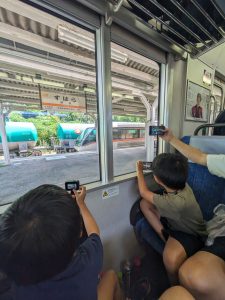
I encountered this dad and his two train-loving sons when I squeezed in next to them to sit in the last remaining seat after a transfer. They were headed home after a trip to Nagoya and were also using the Seishun 18 Kippu to ride the slow, scenic local lines!
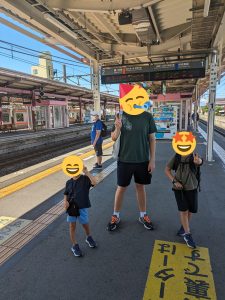
We parted ways at Shiojiri Station; I was headed north toward Matsumoto & Nagano and they were headed south back to Tokyo. Dad wanted to take a picture of us together on the platform.

Another view of Chikuma City. I’d like to come back here as I’ve learned there’s a small statue by Tarō Okamoto in the area, one of my favorite artists, of Tower of the Sun fame.

No IC card usage here on the fare gates in Nagano City! Maybe this’ll change with the introduction of the revised, Mutual Use-compatible KURURU early next year?

Nagano Dentetsu counter for buying the old KURURU cards, available until they’re retired at the end of January. You could buy one with PayPay (e-money), not just cash, which was a first for me.

I went to get curry and they had a guestbook. The juxtaposition of a children’s comic on one page next to calculus on the other was amusing.

Irasutoya spotted. I was traveling during the Olympics, so this display was to support the athletes, saying “Go, Japan!”

Obon Ennichi at Zenkō-ji, a Buddhist temple built in the 7th century, which the modern city of Nagano was built around. The temple was built before Buddhism split up into different sects, and so it is co-managed by 25 priests from one and 14 from another.

I saw this “Beer Train” sitting on the opposing track in the station I arrived into, providing a special all-you-can-drink ride. The front of the train was two stories and looked pretty funny – turns out it’s an Odakyu 10000 series (more pictures at the link) that used to be used for Romancecar services in Tokyo, from the 80s up until 2012.
Sunday, August 11
Today’s transit:
Hokuriku Shinkansen (Hakutaka 553) ‐ toward Kanazawa
25 min (2 stops)
9:54 Joetsumyoko Station
Shirayuki Limited Express ‐ toward Niigata
2 hr (10 stops)
12:30 Niigata Station
IC cards obtained: RYUTO

Look how this company represents the orthographical choice of the “toki” part of “tokimeki” being written in katakana (!!!)

I made it in time for the Niigata Festival’s Sumiyoshi procession! The coolest part about this was, unexpectedly, getting to see a real-life matoi! The object being twirled is a tasseled flagpole which was used as a visual alarm by fire brigades in the Edo period, and is still used ceremonially. I learned about this originally through Tricolor Turf War battles during Splatfests in Splatoon 3, where they lent inspiration to the Sprinkler of Doom game mechanic. I talked with the guy and he let me carry and twirl it too – it was so heavy!!! Video on Twitter here.

Across the street, for some reason, MLIT had set up a “rainfall experience device” where it let me feel the strength of the heaviest rainfall ever recorded in Japan (which, by the way, was over 1 meter in 24 hours, in 1957, in Nagasaki).

Found my favorite rhythm game, WACCA! I made an effort to stop by arcades at night in most of the cities if they had any cabinets (following a poor launch due to COVID, it was taken offline & removed from most big-city game centers in 2021, but it’s still around mid-sized and small cities, with less demand to always have the newest trendy games…)
Monday, August 12
Today’s transit:
Hakushin Line Local ‐ toward Murakami
35 min (9 stops)
9:40 Shibata Station
Inaho Limited Express ‐ toward Sakata
1 hr 30 min (6 stops)
12:42 Tsuruoka Station
Highway Bus (Shonai Kotsu/Yamako Bus) ‐ toward Sendai
2 hr 50 m (5 stops)
17:00 Sendai Ekimae
IC cards obtained: Shibata BusDokoPay, shoko cherica, icsca
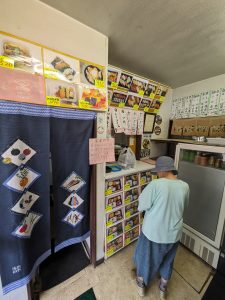
Got off at sleepy Shibata City to get an IC card. Then I got some fresh sushi for lunch from this cash-only shop run & exclusively visited by senior citizens. :)
It turned into a rainy, overcast day, but was a lovely oceanside ride to Tsuruoka. The Uetsu Main Line has been featured on the seasonal Seishun 18 Kippu poster a number of times over the years. Some examples of past posters here and here.

A poster at the Tsuruoka highway bus station which showed all the 2-in-1 regional cooperation IC cards you could get around Tohoku. I told them that was exactly my agenda! :)

I had a bit of time to kill, so I went to this wonderful fruit shop, Aomoriya, which had unbelievably delicious fruit tarts and juice.

A weather report about the typhoon, Tropical Storm Maria aka Typhoon #5. Thus the rainy weather earlier! It luckily was passing just north of me, and the Pokémon with You train line, which had some portions of the track washed away in the storm, just reopened the day before I was scheduled to take it. So lucky… :’)

The bus ride was truly beautiful. It was winding, with spotty service, through mountainous Yamagata on winding roads through many tunnels… extremely fitting for Mountain Day, which just happened to be today!

Stopped at a highway rest stop, and saw…. ZUNDA!!!! The absolute sign that you’re in Miyagi Prefecture and nearing Sendai. More on zunda later. Much, much more.

I only collect train station stamps, not random ones like this one at the rest stop, but I still took a pic.

Of course I got gyutan for dinner – a Sendai specialty.
Tuesday, August 13
Today’s transit:
Senzan Line Local ‐ toward Yamagata
1 hr 25 min (19 stops)
12:26 Yamagata Station
Yamagata Shinkansen (Tsubasa 142) ‐ toward Tokyo
1 hr 25 min (3 stops)
14:29 Koriyama Station
Ban-etsu-West Line Rapid ‐ toward Aizu-Wakamatsu
40 min (4 stops)
15:58 Inawashiro Station
Ban-etsu-West Line Rapid ‐ toward Koriyama
40 min (4 stops)
17:36 Koriyama Station
Tohoku Line Local ‐ toward Fukushima
45 min (10 stops)
20:28 21:02 Fukushima Station
Tohoku Line Local ‐ toward Sendai
1 hr 20 min (19 stops)
23:21 Sendai Station
IC cards obtained: yamako cherica, NORUCA, NORUCA (Ultraman Zero design), AIZU NORUCA

In the morning, I set off on the bus to Sendai’s Minamikoizumi Traffic Park, the only place in the country where these UFO-style traffic lights are still installed. They used to be on a few public roads in Sendai until they were removed from operation literally just two weeks before my trip!!!!! They were originally designed in Nagoya in the 70s and one can still be found in the Ōsu neighborhood, “floating” above the center of an intersection with the pedestrian signals built in, but with a slightly different detached design and updated to use LEDs.
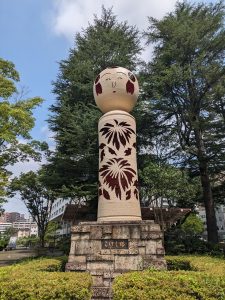
Kokeshi dolls are another symbol of the city, originally from the Tohoku region and the word “kokeshi” itself Sendai dialect (fun fact!) This giant one is in Nishi Park.

I was in Sendai, so… I just had to recreate Red Parka (aka Broken Wear). Let me tell you, this video was all the rage in 2008. Realizing I was in the city where it was filmed, before my trip, I looked up what the creators had been up to in the past decade-and-a-half… (will return to this point later…!)
A very pretty train ride toward Yamadera (which I hiked in 2017!) through huge mountain valleys and over many bridges. Out the window were the tops of trees.

I loved this sign. Just get off! Another one told passengers what to do “When I got off the track” (the speaker, “I”, being “the train” here, naturally).

In Yamagata’s bus center they had this demo IC card reader made of paper to show the countryside kids & seniors how to tap their newly purchased cards :’)

Nice train. (If you clicked all the links in this post so far, you should get this reference.) Sadly wasn’t one of the brand-new E8 series trains that just entered service in March, though!

I got one for a friend, plus some Shinkansen too hard ice cream, obviously.
More nice views from the Yamagata Shinkansen!
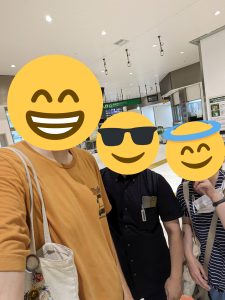
In Koriyama Station, I spontaneously met up with my IC card-collecting friend Sunagawa-san and his wife… we found out we were both passing through the station, over one-and-a-half thousand kilometers away from his hometown of Fukuoka, literally five minutes ahead of time when I saw he posted a picture of the IC card I was on my way to get at the exact time. Insane coincidence.

After hearing I was collecting IC cards, the manager at this Fukushima Transportation office ran into the back and offered to sell me this commemorative NORUCA design?!?!? Turns out it’s from 2010, and she only charged me ¥500 for the standard price (“deposit”) of the card; it’s scratched up and has a usage history, and even came with some yen loaded onto it… perhaps her personal card, or one that was recently returned and they hadn’t gotten around to throwing away yet?! Definitely an unofficial sale, lol, but SO, SO KIND and I was absolutely euphoric.

I wasn’t the only one who thought the inland-bound ride on the Ban-etsu-West Line! was nice. At Aizuwakamatsu, the last segment of the line that’s electrified, there’s a connection to the Tadami Line – one of the most scenic railways in Japan which I’d love to ride someday.

View from the walkway connecting the two island platforms at Inawashiro, population 14,000 (quite a bit higher than I would have guessed!) I would have loved to go all the way to Aizuwakamatsu but didn’t have enough time! But it would definitely have been on the agenda had I had an extra day.

Probably my favorite landscape picture from the whole trip. The surroundings here were just stunning. So green, so blue.

Got my AIZU NORUCA (not compatible with Fukushima’s similarly-named NORUCA…), a brand new IC card for the region that had just been released on July 27!

One of my FAVORITE mistranslations ever. Etymology for the Japanese word for platform: English ‘platform’ → Japanese プラットホーム purattohōmu → clipped to simply ホーム hōmu, which then from time to time gets incorrectly interpreted as the phonetically-identical pronunciation of the English word “home”.
Then suddenly, guerrilla rainstorm!

Despite a delayed train, I made it to Fukushima Station (halfway back to my hotel in Sendai) where they had a lot of eki-stamps, one for each shinkansen series/model.

Huge straw sandals, waraji, on display! They have a whole festival here dedicated to them. Each one weighs 4000 pounds and are carried by teams of people.

Perhaps ironically post-3.11, Fukushima City boasts some of the cleanest drinking water in Japan. Here’s a public tap just outside the station.

Very old-school station. Serves Fukushima Transportation’s Iizaka Line and the third-sector Abukuma Express Line. NORUCA only. There was a warning sign saying to not put your card near electronic devices with a photo of a flip phone on it!
Rain made for some cool nighttime views out the window.
Wednesday, August 14
Today’s transit:
Tohoku Line Local ‐ toward Kogota
45 min (11 stops)
10:34 Kogota Station
Ishinomaki Line Local ‐ toward Yanaizu
15 min (3 stops)
10:59 Maeyachi Station w/ through-service to Kesennuma Line
25 min (5 stops)
11:21 Yanaizu Station
Kesennuma Line BRT ‐ toward Kesennuma
1 hr 50 min (23 stops)
13:22 Kesennuma Station
Ofunato Line (POKÉMON with YOU Train) Rapid ‐ toward Ichinoseki
1 hr 55 min (6 stops)
16:32 Ichinoseki Station
Tohoku Line Local ‐ toward Morioka
1 hr 35 min (19 stops)
18:57 Morioka Station
IC cards obtained: odeca

My first of many zunda shakes. Zunda is a delicacy from Sendai made with soybeans, so this is essentially a soybean-flavored vanilla shake, and they are so good. Apparently there used to be one of these stores serving them, a Zunda Saryo, store in Hawaiʻi – in Shirokiya in Ala Moana – but it closed in 2017…!!!
The Japanese system of shisa kanko (pointing and calling) in action.

At Yanaizu, the de facto end of the Kesennuma rail line after 3.11, the 2011 Tohoku earthquake and tsunami, which destroyed much of this region.

Due to the prohibitively high cost of restoration, services beyond Yanaizu on the line were turned into a BRT (bus rapid transit) service, running on a dedicated single-lane road that was paved over the old rail track. This BRT system is operated by JR and treated the same as a train line, just served via bus instead.

Not as nice compared to a train, and with worse air conditioning, for sure, but it was cool to experience JR’s only BRT service along the coast in this region of the country that was so badly devastated by the disaster.

Another BRT bus, seen during a stop at one of the station buildings, which are essentially used as park-and-rides and shopping centers now. Oppo-kun, the odeca squirrel mascot, spotted!

After my train got in & getting my IC card, I only had about 45 minutes for lunch, so I ran 15 minutes into town to eat at this tiny eatery, gobbled up my meal and darted back to make it just in time.

Interior decor. It was a second-generation shop run by a husband-and-wife duo (although I suspect she did most of the work), and she said she’d make anything I wanted within her ability.
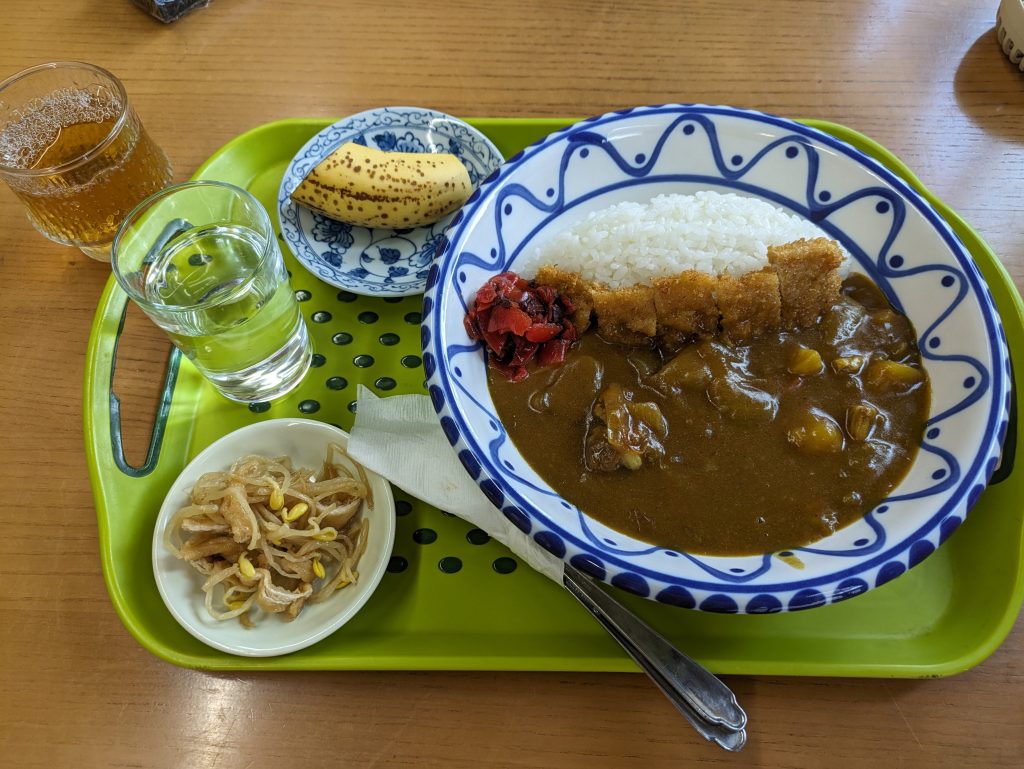
I said that I’d defer to her suggestions, and she proposed katsu-curry, so I went with that. I also chatted with another old man, a friend of theirs, who was there every day for lunch and had grown up right around the corner. He spoke in heavy Kesen dialect (and was missing a few teeth) so it was kind of hard to understand him :’)

Pokémon train!!! This service is one of JR East’s Joyful Trains and was created in attempt to draw visitors back to Iwate Prefecture, and contribute to regional revitalization.
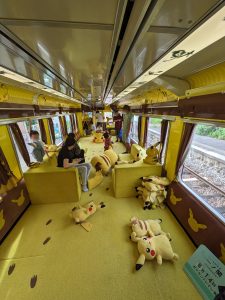
The other car was a GIANT PLAY AREA. While the line required reserved seats, naturally, hardly anyone sat in them.

Pokémon hedges at one of the stations. There was endless decoration like this at every one of the seven stops, and the train stopped at many for an extended period of time, during which passengers could get out, explore, take pictures, and get a commemorative stamp.

The Ofunato Line also gets called “dragon rail” due to its shape, which is said to resemble that of a dragon’s curvy tail.

A sticker on one of the non-special trains that we passed. See the “route map” in the sidebar of the Wikipedia article to see the shape of the line.

The Pokémon train only runs once per day, on selected days, so a lot of passersby come to watch and wave hi (on the left).

This group of train-obsessed children wanted to practice introducing themselves to me in English and then taught me lots of random Japanese train words like “ballast” and “branch line” and “reduction in the number of vehicles”.

I LOVED this signage. The standard dot separating the different platform numbers got Pikachu ears added.

THE BEST MASCOTS. Morioka is famous for three great noodle dishes, so the Iwate Prefecture tourism bureau created this series of characters based on different regional specialties. On the other hand, these shinkansen mascots were terrifying. No thanks.

Loved this sign, stylized as FES”AN but pronouned “fezan” as if the dakuten were applied to voice the English /s/ and turn it into /z/ as well. I had actually made a similar joke to my fellow linguist friends from undergrad just a few months prior, so this made me super happy.
Thursday, August 15
Today’s transit:
Akita Shinkansen (Komachi 9) ‐ toward Akita
Car 15, seat 8-A
1 hr 35 min (4 stops)
12:33 Akita Station
Ōu Line Local ‐ toward Shinjo
50 min (8 stops)
16:34 Ōmagari Station
Tazawako Line Local ‐ toward Morioka
2 hr (17 stops)
18:58 19:01 Morioka Station
IC cards obtained: iGUCA, Iwate Green Pass, AkiCA
More of a chill day today – just out to Akita and back. I went early to Morioka Station to watch the shinkansen coupling in action! This is a Komachi train on the east–west Akita Shinkansen line joining up with a Hayabusa train from the northern Tohoku Shinkansen, to continue southward toward Tokyo. (About a month after my trip, these trains accidentally came uncoupled while in motion…!)
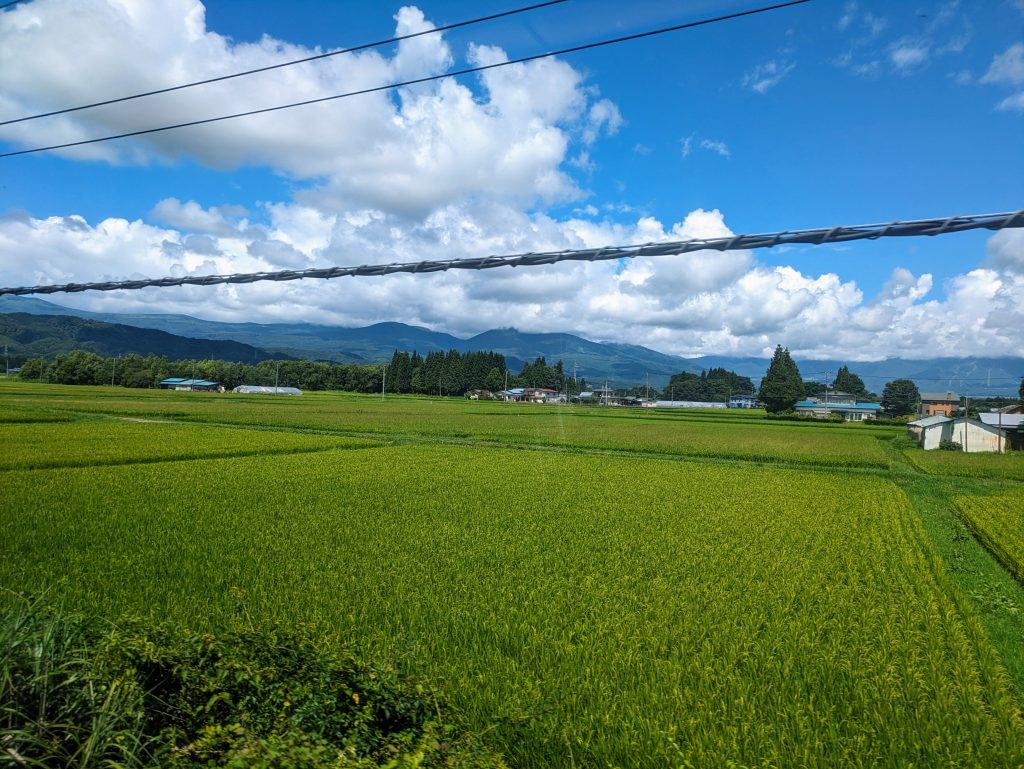
Surprise surprise, another very pretty train ride. I chatted with a very nice, talkative older women who offered to sell me her beautiful but mouse-infested old house in Matsumoto for the equivalent of $2000 and said if I know anyone around 40 years old for her recently divorced TV commercial director daughter to marry, I should let her know.

Akita is also famous for their folklore of namahage, with their oni/ogre masks depicted here.

The station showcased photos of what the area looked like in the winter… which, given that the summer days here were around 35°C / 95°F, was making me very, very, very jealous…

Senshū Park has a near-daily event put on by the Akita Inu Preservation Society called Akita Inu Fureaidokoro where you could meet & pet Akita dogs!!!

This good 3-year-old Akita was named Hokusyoren, while her 2-month-old brother in the photo to the left was Jill.

I know I can be hyperbolic & overexcitable at times, but I mean it when I say this is maybe my FAVORITE SIGN EVER. Gorgeous rings are dangerous to dogs!!!!! Also, I met another family here who were looking to adopt one of the dogs, and it turns out the daughter was from Nagoya, back home in Akita for the week visiting family! We exchanged contact info and (writing this post now, three months after my trip) just grabbed a meal a couple weeks ago!

Back at the station for lunch, eating Inaniwa Udon, a local specialty. All I ever wanted on such a hot day.

I spontaneously decided to take the local lines back (a great choice!) This shows my exact route, and points out that while Akita and Morioka & their surrounding areas are both within the Suica area, allowing for the use of IC cards, the area in between is not – so if you’re going there, paper tickets only! Naturally, my paper all-you-can-ride pass made it so I could freely exit and enter anywhere. :)

The eki-stamp at Ōmagari Station, where I transferred from the Ōu Line to the Tazawako Line, describes it as the station “of fireworks and switchbacks”.

Ōmagari Station is in the city of Daisen hosts Tohoku’s largest fireworks festival anually in late August, a free event that’s been running for over 100 years and draws 700,000 spectators. For the “switchbacks” portion – that’s pictured here! This is the tail of a Y-shaped junction, where trains pull in and back out. The left track is used for conventional trains and the right one is for the Akita Shinkansen, a rare instance where shinkansen trains share tracks with local lines.

I enjoyed this seating layout, and thought it was pretty unique out of trains I’ve seen! Longitudinal seats on one side with double transverse seats on the other, and then it flips halfway through the carriage.
Getting passed by the shinkansen!! Like the Yamagata shink, the Akita Shinkansen line is a mini-shinkansen, meaning that it was a formerly narrow-gauge railway converted to a standard gauge, so that they can through-run with the shinkansen network. They also share tracks with local lines (as seen here!) and thus run at slower speeds than the high-speed shinkansen.

Got off at Kakunodate Station where we were stopped for a bit to get an eki-stamp, and happened to see a sign for a non-JR railway, where this nice-looking train on the Akita Nairiku Line was waiting! This is the only line run by the third-sector “Akita Inland Longitudinal Railway” company. The employee let me through for free so I could take a picture, and of course I grabbed their stamp too.

I liked this circular stairwell-rotunda-thing that takes you underground to get across the street from the station (of course, it’d be better if there weren’t a large road right outside it in the first place, but I digress…)

After eating jajamen the night before, tonight I decided to try the cold Morioka reimen, another of the city’s famous noodle dishes. The watermelon was unexpected but good!

A very rainy night. Decided to stop by a konbini after this, on the other side of the station from my hotel, and got caught in a torrential rainstorm where I almost lost my wallet, saw some gutters overflowing and pouring water into the street, jumped in puddles, saw a huge spider, and finally made it home after taking refuge in a covered walkway and waiting for it to let up a bit.
Friday, August 16
Today’s transit:
Iwate Ginga Tetsudo Local ‐ toward Hachinohe
1 hr 19 min (17 stops)
12:54 Metoki Station w/ through-service to Aoimori Tetsudo
30 min (6 stops)
13:21 Hachinohe Station
Aoimori Tetsudo Local ‐ toward Aomori
1 hr 35 min (20 stops)
16:20 Aomori Station
IC cards obtained: HACHICA, MegoICa, AOPASS

A much sunnier day the next morning! I walked to the Morioka Bus Center, about a half hour walk from the station, to get my Iwate Green Pass that I had bought at the station info desk the day before registered in my name – like I like to do for all my IC cards.

They advertise Takarazuka in Morioka???

Ten minutes before my train out of Morioka Station, I suddenly met Ginga-kun, the mascot of IGR Iwate Galaxy Railway (the first of two third-sector railways I rode today), along with one of the prefectural tourism mascots I mentioned previously. Ginga-kun is a star, and Unicchi is based on an uni (sea urchin) bowl of wanko soba!

Hachinohe had SO many stamps. (Because they centralize them instead of having them at all the small, local stations…)

I am OBSESSED with the mascot of Aoimori Railway. His name is Mōrī, aka Molly, and he’s a blue tree, the literal meaning of “aoi mori”.

Of course I bought a mascot of him to add to my transit mascot plushie keychain collection for my bag.

Why would you have to pay directly on the train? Because many of the stations are unmanned and there’s no IC card support on the line!
Walking to my hotel in Aomori, I noticed… THE CROSSWALKS HERE PLAY THE SHINKANSEN GATE DOOR MUSIC????? Literally stopped me dead in my tracks. Turns out it’s a classical piece, a piano composition called “A Maiden’s Prayer” by Polish composer Tekla Bądarzewska-Baranowska. I have no clue why East Asia knows this song, but apparently the garbage trucks in Taiwan use it too. Is there some Auld Lang Syne/Hotaru no Hikari situation going on here??
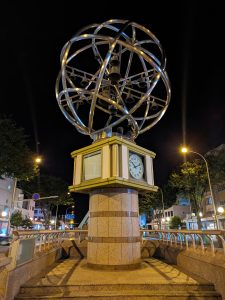
Aomori has a number of carillons, an instrument I’d never heard of before, for some reason? (Edit: Apparently they exist in the city I grew up in too, and I just forgot…???)
Saturday, August 17
Today’s transit:
Ōu Line Local ‐ toward Akita
1 hr 35 min (17 stops)
12:18 Ōdate Station
Ōu Line Local ‐ toward Hirosaki
45 min (8 stops)
16:11 Hirosaki Station
Ōu Line Local ‐ toward Aomori
55 min (9 stops)
17:44 Aomori Station
IC cards obtained: Towada SkyBlue Pass, Shuhoku Orange Pass

I guess by “Today’s transit” I really just mean trains, because the next morning, I took a TINY BUS (the city buses are all this size!) to get the third and final of my Aomori IC cards, which is actually from the city of Towada to the east but has a sales office in Aomori City.

…but not really in Aomori City. Had to walk 15 minutes from the bus stop down this gravel path with no shade to a random office in the middle of a sea of auto body shops. Definitely the most off-the-beaten path I’ve had to go for a card so far.

Two iconic landmarks of the city, the Nebuta Museum WA RASSE and Aomori Bay Bridge.

Aomori is most famous for their apples, and the nearby A-FACTORY sells all sorts of local apple goods. I bought one each of these packs of dried apple slices to eat on my train (the horror!)

Odate across the prefectural border in northern Akita Prefecture, and known for their kiritanpo, as seen on this eki-stamp.

More famously, though, Odate is known for being the birthplace of faithful dog Hachiko, the most well-known and beloved Akita Inu of all time and undoubtedly the famous famous dog in Japan.

On walking around Odate, I stumbled upon this absolutely incredible independent arthouse movie theater named Onariza. The sign for Zigeunerweisen is what initially caught my eye!

Onariza has been around since 1952 and is filled with an endless amount of movie memorabilia and trinkets collected over the past 70+ years. I talked with a very punchy older woman (forgot her name!) in the lobby, a regular who has been traveling 40 minutes on the train each way to watch movies at the theater every single weekend for decades. I told her of my love of film and she offered to give me a tour of the place.

The theater’s mascot and idol is Teppii-chan, the live-in rabbit who passed away a few years back. The lobby is filled with rabbit toys, plushies, flowers, and pictures to honor her memory.

The most incredible part of Onariza is that every. single. movie. they had shown for over half a century had a hand-painted sign created for it and hung outside. But… what’s this?

They even had a showing of RRR!

The cool, old side hallway. If I had more time or had known about this beforehand I would have 100% gone to see a movie here – and if I lived anywhere in the area, I’d be going all the time.

During COVID, Teppii-chan’s photo got used as physical distancing signage!!! Ahhhhh!

Teppii-chan munching on a carrot. I told my new friend how much I loved rabbits and how special all their memorials to her were and she showed me a bunch more photos.

They were in the middle of a sign change for the ongoing film festival, so the main sign showing the theater name is obscured by other wooden signs resting against it, but here’s the building from the street.

Odate, crossing over a bridge. You can see the daimonji, or the character 大 (“big”), carved into the mountain, which will be burned at the end of Obon.

You know you’re in the inaka when there’s a guy fly fishing in the river, as my friend (who formerly lived near Odate back in 2017!) put it when I sent him this photo.

Also tried kiritanpo, which I couldn’t find a close-by place to do a few days prior when in Akita City!

On my way to get my final Honshu IC card, I stopped by the Akita Dog Museum, which has tracked the breed’s companionship and relationship with humans for hundreds of years. The museum was founded by the Akita Dog Preservation Society and keeps track of every purebred Akita Inu worldwide. Sadly, the meet-a-dog area was closed, but I already got to do that earlier in the week :)

Made it to the Shuhoku Bus office. I liked their little kamidana. My workplace has one of these too lol.

Advertisements to go visit Tokyo. I feel like people in the inaka might see this and start singing Yoshi Ikuzo’s Ora Tokyo sa Iguda… Ora konna mura iya da, ora konna mura iya da…
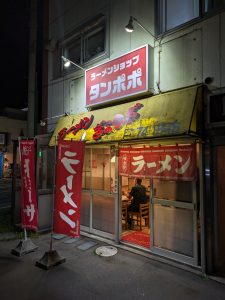
Got ramen for dinner at a shop called Tampopo. Sadly, not named after the Juzo Itami movie… (I asked.)
Sunday, August 18
Today’s transit:
Ōu Line Local ‐ toward Tsugaru-Shinjo
5 min (non-stop)
8:28 Shin-Aomori Station
Hokkaido Shinkansen (Hayabusa 95) ‐ toward Shin-Hakodate-Hokuto
1 hr (non-stop)
10:01 Shin-Hakodate-Hokuto Station
Hakodate Line Local (Hakodate Liner) ‐ toward Hakodate
20 min (5 stops)
10:30 Hakodate Station
Hakodate Line Rapid (Hakodate Liner) ‐ toward Shin-Hakodate-Hokuto
25 min (5 stops)
12:29 Shin-Hakodate-Hokuto Station
Hokkaido Shinkansen (Hayabusa 28) ‐ toward Tokyo
2 hr 30 min (6 stops)
15:29 Sendai Station
Tohoku Shinkansen (Yamabiko 192) ‐ toward Tokyo
2 hr 5 min (5 stops)
20:28 Tokyo Station
Tokaido Shinkansen (Hikari 665) ‐ toward Nagoya
2 hr 0 min (6 stops)
23:04 Nagoya Station
IC cards obtained: Kitaca, ICAS nimoca

Headed up north to grab two IC cards before heading back toward home. There were some miniature Nebuta floats in Shin-Aomori Station!

Reached Shin-Hakodate-Hokuto, where the shinkansen tracks come to an end… until 2031!!!

In Hokkaido for the first time, my first order of business was to go to the much-beloved Hokkaido-only konbini, Seicomart!!!

I found some Kitaca goods featuring my favorite flying squirrel mascot, but sadly no plushie keychains :(

Heading back to the shinkansen station from Hakodate City: SOMEONE BROUGHT SEVEN 9-DAY-OLD PUPPIES ONTO MY TRAIN.

On the shinkansen back to Honshu, going through the Seikan Tunnel, the world’s longest undersea tunnel! Fun fact is that there are actually two stations in the tunnel: Tappi-Kaitei and Yoshioka-Kaitei Station, now only used for maintenance & as escape points in the case of emergency. They were the world’s first two undersea railway stations when they opened in 1988, also having the lowest elevations in the world. Both were built as part of the conventional Kaikyō Line through tunnel before the shinkansen opened, and only accessible on tours. I tried to capture this picture of one of the dimly lit pathways leading into one… not sure if this is it or something else, but let’s just say it is for coolness’ sake.
When, on a whim, I decided to look more up about that old video that I recreated pictures of myself miming, Red Parka, I found that its creators were a bunch of high school friends from Sendai. And 15 years later they’re largely still here, still making weird performance art and artistic performances. They’re called SIRO-A (白A) and actually have gotten pretty big; they were on America’s Got Talent in 2015 and made it as far as being in the semifinals, as second runner-ups. They do a ton of stuff now with lights and colors and projection mapping. I watched their past videos, and I looked up their future works… and they were performing a show in Sendai. When I was there. The only performance that barely worked with my already-planned schedule was the very last show on the very last day of their two-week stint in their hometown, put on in a recently constructed community center right outside the park which houses the ruins of Aoba Castle, the home of the first daimyō (feudal lord) of Sendai Domain, Sendai’s own endlessly beloved boy, Date Masamune (that’s two-syllables, /dɑːte/, not like to go on a /deɪt/). The show was called Date Romanesque.
This was a bonkers community theater/interactive musical dance production all about the history of Sendai and the trials and tribulations undergone by its much-revered founder, complete with smoke and water guns and greenscreens and original music compositions and a talking head trivia show with puppets. It was crazy and so, so good.
They had three synchronized projectors and really broke the proscenium, making full use of the 3D space.
Filming the show was extremely encouraged, so I got some videos of their totally unique, inventive, hilarious performance.
They must’ve had so much fun figuring out how to do all this with projections.
They went around taking pictures of everyone with this homemade greenscreen before the performance and then involved them like this. lmaooooo. But seriously: How do I get involved with the people doing cool arts stuff here, please!!! I mentioned to one of the guys from the troep after the show that I knew them from Red Parka (a lot of the audience was interested how I found out about the hyper-local show…?) and he was like hahaha, oh my god, what a throwback.

One VERY last zunda shake…. well, they have outlets in Tokyo and Osaka too. Both of which I’ve been to in the past couple months before writing up this post lol. No shame.

Transferring in Tokyo Station. Did you know this realtime arrival dashboard is apparently publicly accessible? I found a screen with the URL showing a while back. Here you go: https://contents.hikarisignage.net/jrc/jrTimetable/?Setting=S1P8D1
And then I was home, and the trip was over, and I slept.
The postscript is that while working on this post, on October 24, the JR Group announced the Winter 2024 Seishun 18 Kippu – which radically changes its usage conditions for the first time ever since 1984.3Press release: https://www.jreast.co.jp/press/2024/20241024_ho01.pdf Its five days of use now must be fully consecutive, selected in advance, and it can no longer be shared between people. No more families using it to go on a weekend trip together. No more posters showing groups of kids using it to go on an adventure with the freedom and indpendence that transit provides. It’s really not the same ticket at all; they’ve killed it, and just branded this new thing under the same appropriated name that shares some vague similarity to what it was before. At least you can go through automatic fare gates now…? “Yay”? There are no real use cases for it for the average person anymore, much less youth. A lot of people suspect this is intentional, a sly step toward eliminating it in the near future after “proven data” shows that sales numbers have turned abysmal, gifting them rationale to deal the final blow. The word on the street is that they didn’t like that people were reselling unused portions of it at third-party ticket shops or something. Boo hoo. Not compatible with endless growth and profits. Must protect the privatized system. Corporate greed over satisfaction. To be clear, this is the type of stuff that kills railways, in the most pitiful way: socioculturally.
Sorry to wind down on a depressing note, but it is frankly pretty darn sad (and personally, has also resulted in me changing the route of my winter Hokkaido trip considerably) and I am quite bummed, as is nearly everyone else. Feels like years of culture and community and shared experiences are already beginning to fade away. And so I guess this so-called “Juu-Pachi Kippu” trip will be the closest I ever get to actually using it for real. Capitalism wins in the end. Poo-tee-weet, so it goes. (Bring back JNR.)
Oh, yeah, right, almost forgot amidst the doom and gloom – my IC card haul! Ta-da!!
P.S. This trip made me fall in love with conventional/local railways and I will pretty much always prefer them now if I have time; this past weekend, I cut seven minutes (and got to save a whopping ¥870… I’m rich!!) out of a spontaneous shinkansen trip from Kumamoto toward Hiroshima to instead get off at Tokuyama, which added two hours of travel time onto my route home. But as a result, I got to get my first-ever eki-stamps & ride my first-ever trains in Yamaguchi Prefecture, and take the Sanyo Main Line along the coast of the Murotsu Peninsula, looking out over the Seto Inland sea from the north… it was a wonderful ride, as expected, and if I have the time, I will do this time and time again. The shinkansen is fast and great, but it is also point-to-point, and there is always so much in between – funny signs, people to talk to, things to see or stumble across, unique snacks, stamps, yadda yadda yadda to infinity, all of which I would never want to deny myself if I could help it. It’s the best way to see the world, after all! Who cares if I don’t have some fancy unlimited-ride pass! Nothing will stop me! Take that, JR! (says eli as he hands over more money for train tickets)







